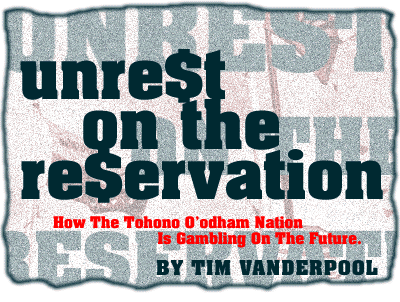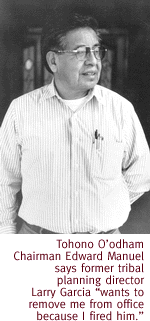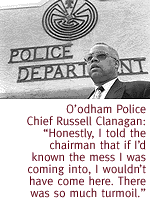
THE FLAG OF the Tohono O'odham Nation flaps outside the
gleaming Desert Diamond Casino, its string of black feathers undulating
wildly in the crisp breeze. Each of those 11 feathers symbolizes
a district on the tribe's vast reservation, thrusting west nearly
to Ajo and south to the Mexican border. Many of those districts
are as remote and isolated as any found in this hemisphere, the
lives of their inhabitants as rooted in past as in the present.
It's not rare to find rural O'odham villages completely bereft
of indoor plumbing, or architecture that relies mostly on mud
and ocotillo.
Arguments, coming primarily from whites who own flushing toilets,
hold that modernization is no panacea for these traditional people.
Meanwhile, the majority of villagers survive on bare subsistence.
Sixty-five percent fall below federal poverty levels.
 South Nogales Highway acts as a concrete funnel into the Desert
Diamond. Today it carries a city bus, which rumbles to the casino's
edge and empties a cargo of Anglo faces. The small band, mostly
older folks in light coats, some toting big shoulder bags stuffed
with sweaters or lunches, chat cheerfully as they stroll through
a turquoise-colored gate and past stern-faced security guards
wearing bulky nylon jackets.
South Nogales Highway acts as a concrete funnel into the Desert
Diamond. Today it carries a city bus, which rumbles to the casino's
edge and empties a cargo of Anglo faces. The small band, mostly
older folks in light coats, some toting big shoulder bags stuffed
with sweaters or lunches, chat cheerfully as they stroll through
a turquoise-colored gate and past stern-faced security guards
wearing bulky nylon jackets.
In many ways Desert Diamond and its clientele represent the future
of the Tohono O'odham people. Bearing the architectural sensibilities
of a huge strip mall, the casino nearly covers a complete city
block. An enormous neon sign, domed porticos, mauve trim and water
trickling from an iron cactus attempt to soften its utilitarian
edge.
Annually, visitors here dump a $60- million windfall into the
casino's slot machines, bingo contests and card games. That money
promises full coffers for a tribe far more accustomed to financial
scarcity.
But after surviving rigorous outside assaults by powerful Nevada
gaming interests and this state's dog and horse tracks, all led
by convicted felon and former Arizona Governor J. Fife Symington
III, the casino now faces a fight entirely of its own making.
Competing reservation factions, led by a disgruntled former tribal
employee and his non-O'odham protege, have tried to use the casino's
remarkable profits as a lever to pry support from the nation's
current administration and its chairman, Edward Manuel.
Ironically, even as Manuel's critics question his handling of
the funds, they've laid bare their own mottled legacy of bureaucratic
ineptitude and inaction, and revealed why so much of the O'odham
existence is still mired in projects that never happen, progress
that never sticks, solutions that never see the light of day.
Of course, in many ways political fights among tribal members
are no different than those erupting on any given day in Tucson
City Hall or between county supervisors. Still, city and county
leaders represent only broad constituencies, not a unique, ancient
and increasingly fragile culture. And that is a profound difference.
Ultimately, at the heart of the O'odham Nation's internal struggles
are not only gambling proceeds and how they're spent, but also
the way its people tailor their own identity on the brink of the
21st century.
IN A JUNE vote of 1,575 to 1,254, tribal members awarded
themselves a biennial, individual $2,000 cash disbursement from
casino earnings. After taxes, that leaves every registered man,
woman and child about $1,300. Minors would have the money placed
in escrow accounts, and distribution was to happen within 90 days.
It would be the biggest disbursement of its kind by any tribe
in the United States; just before the balloting, an additional
900 unregistered O'odham rushed to get on the rolls.
And it would cost the tribe dearly. According to one O'odham
government insider, "We blew $80 million just to pay for
the initiative. At the least, it certainly made us more cost-conscious."
Nor it is a secret that the vote was in large part a backhanded
referendum on Chairman Manuel.
Former tribal Planning Director Larry Garcia spearheaded the
initiative, which also required the tribe to fund a $30 million
youth center project, award $15 million in business grants, give
$1 million to charity, and earmark another $1 million for helping
poor O'odham pay their utility bills.
Chairman Manuel had fought the measure, saying it would threaten
the nation's financial future, and force his government to scale
back many of its own projects, including a planned $14 million
senior care center. It could also breach the tribe's gaming compact
with the state, he said. Under federal guidelines, that pact required
a fixed percentage of casino funds to be set aside for economic
development and other programs. And any distribution plan would
need approval by the U.S. Bureau of Indian Affairs, which oversees
many tribal functions.
One source close to the Chairman says the initiative was just
a blatant attempt to undermine Manuel. Administrative costs alone
for disbursing the money topped $1.8 million, the source says.
"It blows a hole in our budget and our savings. But that
was (Garcia's) strategy. His second was to push for a recall with
a whole mess of allegations, none of which were true. If you think
about it, this whole thing was more about buying votes against
the Chairman than about giving people money. But I guess Mr. Garcia
didn't care about the economic impact."
The rancor dates back to 1995, when Manuel crushed Garcia in
the chairman's race. After he was installed, Manuel wasted little
time in sacking Garcia as head of planning.
According to the administration source, Garcia was fired for
failing to implement five year's-worth of federal grants. "Now
this is Larry's way of getting even with the chairman. Really,
it's just a naked grab for political power."
Tensions grew thicker when the Chairman waffled on the 90-day
distribution deadline, saying the initiative allowed for a six-month
review by the tribe's attorney general. Garcia immediately seized
on the delay to spark a recall effort against his foe.
Characterizing Manuel as guilty of "malfeasance and gross
neglect of the fiduciary responsibility" for failing to carry
out tribal programs, the recall petition also claimed the administration
raised hell within its police department by installing a controversial
Pennsylvania transplant as chief.
In a thick, open letter dated August 29, Manuel bitterly denied
the charges. "I am outraged at this attempt at spreading
baseless and inaccurate allegations," he said. "These
diverse tactics will only hurt the people of the nation."
The recall crashed badly, garnering support from less than three
percent of qualified voters amidst reports of questionable name-gathering
tactics. One woman claims she was approached on her hospital bed.
She thought she was signing medical papers, only to have her name
appear on the petition.
 Still, Garcia stridently defends his effort. "Hey, it wasn't
just me," he says. "I'm just one person. It's just that
the people brought their concerns to me."
Still, Garcia stridently defends his effort. "Hey, it wasn't
just me," he says. "I'm just one person. It's just that
the people brought their concerns to me."
He says the initiative responded directly to Manuel's misuse
of casino funds. "He hasn't done anything with that money,"
Garcia says. "What was it doing? Sitting in a bank. Meanwhile,
he gave himself a raise, from $50,000 to $57,000, and told the
council they could have raises if they wanted them."
He also points to what he calls dismal morale in the police department.
"The new chief wanted to run the department the way he had
run things back east. He was telling (O'odham officers) they're
stupid, and if they don't know anything, to get out. Now there
are hardly any Indian officers, and that's a problem.
"For example, we had a situation where a non-Indian officer
was called out, and the resident didn't want to talk to him. Those
are the kinds of things that are happening."
Police Chief Clanagan labels such claims mere political smoke,
sparked by his upsetting the good-old-boy apple cart. After coming
onboard, he says he immediately booted a handful of highly unqualified
O'odham officers, many of whom themselves stood accused of criminal
acts. He also cites a backlog of 350 uninvestigated cases that
were still on the books.
"Honestly, I told the Chairman that if I'd known the mess
I was coming into, I wouldn't have come here, he says. "There
was so much turmoil."
A year after his hiring, Clanagan says the nationally-known,
Tucson-based police consulting firm Gilmartin, Harris and Associates
was brought out to plumb his department's performance. "They
came to the conclusion that we needed to change the culture, not
only within the police department, but also how the department
was viewed by the community."
The appraisal led to several changes, including new committees
where rank-and-file cops could air their gripes, and to the policy-tightening
measures that caused a stir. "That left many officers who
were critical of past management saying, 'Hey, we didn't know
how well we had it in the old days,' " Clanagan says.
Those same officers then aimed their wrath towards him, he says,
and took their complaints directly to Larry Garcia.
This year, Clanagan's department has enjoyed a budget boost from
$3.6 to $10.6 million, and his staff has mushroomed to 57 officers,
more than half of them O'odham.
He says his clean-up efforts have won unwavering support, both
from the Manuel administration and from most reservation residents.
"There is something of a cultural barrier. Sometimes we have
to use interpreters. But I don't think when there's a rape call
the victim cares whether or not the officer is O'odham."
While he says tribal members get job preference when possible,
"We've hired O'odham, Latinos, Navajos. The bottom line is
whether they are qualified to be good police officers."
That attitude appears to be at the root of Manuel's support.
Indeed, his election was fueled by his image as a reformer. He
answered those perceptions by bringing in a new team of managers,
beefing up the anemic accounting department, and hiring staffers
with plenty of fresh opinions on how the tribe should be run.
Manuel says he's not surprised those moves angered his detractors.
He calls it a lingering case of sour grapes, particularly on the
part of one man.
"Obviously (Garcia) wants to remove me from office because
I fired him," Manuel says. "And he set a very short
time frame on the (funds distribution). Right after that, he files
a recall. So he's going right out there and saying, 'Well, this
is malfeasance of office, and all these things.' He was using
this and saying, 'See, I told you, he won't even meet the initiative
time frame.' "
He says Garcia's firing was the director's own doing. Or rather,
his lack of doing much. Manuel cites a string of federally generated
Community Development Block grants--to the tune of $6 million--that
the tribe was on the verge of losing because Garcia failed to
implement projects the money was tied to.
For example, there were $600,000 in funds from the Federal Emergency
Management Administration that nearly slipped away, Manuel says.
The money was headed for San Louis, a small village north of Sells.
Built on hard rock, the town had endured ongoing floods, and was
going to use the FEMA money to build a lagoon.
"Larry Garcia was put in charge of that," Manuel says,
"and nothing ever happened with it. So we had to make a change."
Described as a decent, God-fearing sort, but as an ineffective
manager, Garcia left behind one of his lackeys named Jay Cohn.
By some accounts not a popular administrator, Cohn resigned not
long after Garcia's departure. Apparently, it was hardly a surprise.
Nor was his abdication the end of his meddling in O'odham politics:
One source calls him the prime agitator behind Garcia's recall
drive, noting that the petition's language echoed a style Cohn
regularly used on government documents while working with the
tribe.
An architect by training, Cohn was hired as a planning department
administrator in 1994, following stints with the Resolution Trust
Corporation, and running his own Pennsylvania business consulting
firm. Some former co-workers consider him a troublemaker who regularly
tried to sidestep federal grant requirements. Eventually, they
say, he even gained the upper hand on his boss.
"After awhile, it seemed like Larry was just letting Jay
take over," one says. "But that was a mistake. There
were a lot of people with federal and state agencies who wouldn't
even work with Jay. He was extremely difficult, and thought he
could just skirt the rules. At one point he even wanted to take
some of the grant money and start a construction business with
it, even though there was no way the money was ever intended for
such things."
Others say they're still trying to squelch the firestorm Cohn
created. "Many of his actions created tremendous difficulties
for those who remained here," says Terry Flores, grants writer
for the tribe. "At best, I would say his work was very inadequate
and incomplete."
Larry Garcia denies Cohn's involvement in the recall effort,
or that he caused disruptions in the planning department. Cohn
didn't return several phone calls seeking comment.
But what was left in the wake of this contentious duo is public
record.
RENEE RED DOG'S cluttered office lies within a modular
building at Sells, the grubby seat of tribal government located
off a two-lane blacktop one hour west of Tucson. , Half-O'odham,
middle-aged with long dark hair, Red Dog is Garcia's successor,
and she talks in a smooth, sophisticated patter that belies years
spent in government work, and nothing of the clipped tribal accent.
 She says she inherited a big mess in the aftermath of the Garcia/Cohn
regime. "I started here in November of 1996, and things were
in disarray. We weren't project-specific, and I had $8 million
in HUD monies that were in jeopardy of being lost because there
was no movement and no accountability in terms of performance."
She says she inherited a big mess in the aftermath of the Garcia/Cohn
regime. "I started here in November of 1996, and things were
in disarray. We weren't project-specific, and I had $8 million
in HUD monies that were in jeopardy of being lost because there
was no movement and no accountability in terms of performance."
HUD-funded projects come up for annual review, she says, "and
I'm still under pressure, but what I've done is hire more staff.
I'm planning to close out three projects this year."
An example of the backlog is just-completed HUD work that involved
renovating a tiny home. The project dated back to 1989. "It
was like, 'Why was it taking so long to do this one little house?'
" she says. "It was a management issue, to put needed
procedures, oversight and management procedures in place. All
those things had to be sorted out."
Soon she hopes to have grants from 1994 to 1997 running concurrently,
bringing her department up to speed. And she says she's been able
to land $9 million in new funding since last year, ranging from
a $6 million EPA grant for wastewater treatment in villages along
the Mexican border, to $1.9 million more in HUD money.
For most poor reservation dwellers, such numbers probably mean
nothing. But on the human level they matter a lot, Red Dog says.
"There's a real push to utilize those grants, because we
applied for them and we were awarded them. They just weren't implemented.
"Unfortunately, when I go out to the districts and I introduce
myself and explain what I'm planning to do, I hear a lot of the
stories like 'My mom was supposed to get this bathroom, and she
was handicapped, and unfortunately she has passed on.' That's
the sad truth of some the recipients of these grants--they're
no longer even around because of the timeline.
"There are a lot of upset people out there because they're
still waiting for their kitchens and bathrooms, or for their roofs
to be fixed," she says. "And I just have to stand there
in front of them, letting them air their anger and disappointments.
All I can do is try to move those grants along and get these projects
going."
THE STARK, FLAT desert rolls silently past as we cruise
towards Big Field, a tiny village only a few minutes beyond Sells.
Here, a 1994, $400,000 HUD grant is finally being used for adding
bathrooms and showers to a scattering of very old homes. Once
these are complete, construction crews will move on to the village
of Menager Dam, near the Mexican border. In total, the project
will include 42 modern privies for people who previously knew
only outhouses.
We come upon an aging gray house piggy-backed by a new tan washroom.
Visually, it's a very odd congress, the fresh frame addition to
a low-slung, concrete-plastered home, in a place where both the
land and its dwellings have a timeless, clean-swept look.
Nearly all the homes we see are adobe, bisected by ocotillo
acting as rebar. According to the tour guide, who asks not to
be named, securing outhouses to the traditional material has been
a major chore. "We use a lot of masonry to fill in the gaps,"
he says. "Sometimes the addition's doorway is higher than
the house's roof. Then we have to run a bulwark into the home."
Many recipients of this largesse, accustomed to outside facilities,
don't favor bathroom doors extending into their homes. Occasionally,
they decline the improvements altogether.
Others are enthusiastic, like the frail elderly lady who beat
a narrow, foot-dragging trail to her outhouse door. "Obviously,
she's been traipsing out here for years," the guide says.
"Finally, we were able to help her."
These are encouraging signs of tribal government hard at work.
Still, the casino-fund distribution plan could put a wrench in
the works, says Renee Red Dog.
It could happen by raising many reservation residents above the
income eligibility standards for receiving state and federal help,
she says. "That would include things like general assistance
from the Arizona Department of Economic Security, state agencies
for nursing homes, state payments for home healthcare for people
who are bedridden. So there might be a lot of impacts."
And it didn't help that the casino money was finally distributed
the day after Christmas, she says. "People weren't really
thinking about food stamps being cut. They were thinking about
presents. Comes around January, they don't get their food stamps,
but then again they don't have that much money either."
Regardless of the impact, it may be limited to a one-time deal,
according to a recent BIA decision.
"There wasn't sufficient information that significant money
was set aside for economic development and grant programs as required
by federal gaming laws," says Charlot Johnson, BIA tribal
operations officer for the Phoenix Area.
Under those agreements, per capita payments are at the bottom
of the priority list, following economic development, tribal operations
and education. While Johnson isn't specific about how much money
needs to be set aside, she says it "falls in the range of
36 to 38 percent of casino revenues. Any per capita payments are
subject to one-time approvals. Of course, the tribe can come in
with an amended version of their plans, and we would go from there."
Sure, the tribe could do that. But it doesn't seem likely, considering
that distribution opponent Manuel is hardly crying over the agency's
stance. And Larry Garcia says he hasn't seen the bureau's report.
"I'm waiting until I know more about it," he says. "Then
I'll be able to make a more intelligent choice about what to do
next."
But either way--and despite their economic straits--it would
be a mistake to assume that most O'odham supported the distribution
just for its promise of quick cash.
Back at Desert Diamond, a crew plucks weeds from a median running
alongside the casino. One guy stands to stretch, and pulls down
his pointy blue stocking cap. A thin, wiry goatee covers his round
chin.
"The Chairman warned that people were just going to drink
that money up, or use it to kill themselves with drugs,"
he says. "But I still just have mine in my savings account."
That starts his buddies chuckling. "Yeah, lunch is on you,"
one of them hollers.
Another steps slowly along the curb, dousing the ground with
herbicide spurting from a narrow wand. "I don't know what
everyone else is doing with the money," he says. "I
don't drink or smoke. I've been using mine to repair my truck,
and for my two kids. It all went to good use, and believe me it
didn't last long."
He pauses, raising the wand to clear its clogged tip. "Still,
I don't support it," he says. "I had to pay taxes on
it. And the government should be using that money for things that
would help the people long term, like development and getting
businesses going on the reservation. This isn't going to help
that a whole lot."
 Sentiments aren't much different 65 miles away in Sells, where
Annette Frank's weathered adobe home stands at the end of a short,
rutted dirt drive. She perches on the doorstep while one of her
five sons bounces a basketball off the house. The wind whips her
black hair, and her words are angry.
Sentiments aren't much different 65 miles away in Sells, where
Annette Frank's weathered adobe home stands at the end of a short,
rutted dirt drive. She perches on the doorstep while one of her
five sons bounces a basketball off the house. The wind whips her
black hair, and her words are angry.
She says she voted for the funds initiative because it meant
a recreation center for her boys. "There's nothing for these
kids to do around here, no place for them to go. And nothing has
been done about it."
As priorities go, she says the $2,000 came in a distant second,
or maybe even third. "I really didn't look at it as just
getting money. I wanted to send a message. All the residents here,
they don't see where the casino money is going, especially elderly
people that have leaking roofs, things like that."
While not picking political sides, Frank says the initiative
has stirred the pot a little. "I think it has opened the
eyes of Chairman Manuel and the rest of them. Maybe it will wake
them up."
With that, she turns and steps inside. The door clanks shut behind
her. Sounds of the bouncing ball slowly fade in the wind, as a
bank of storm clouds gather like a fist over Sells. It looks like
a night of nasty weather may be in the works.

|





